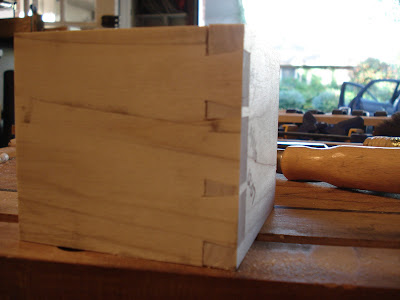Will plane jokes ever get old?
The one essential hand tool that I don't have is a shoulder plane. These are precision planes meant for trimming up corners where two faces meet. The iron (blade) extends all the way over and sits flush with both sides of the tool. They are a must have for executing consistently good joinery and up until now I've just been making do.
There are a number of options out there for these guys: you can buy a nice
Lie-Nielsen,
Veritas, or
Clifton brand new and spend $200-$300. Used ones on eBay don't go for much less. You can also generally find one or two Records on eBay at anytime but a good one will still be around $150. There are also tons of antique wooden ones on eBay, but you never know what you are really going to get there and they'll still run you around $60. Of course one can always go for a nice
Sauer & Steiner too, but the price can be a little discouraging to say the least.
I also saw that you can buy a kit--such as the
one from Hock--and build your own. Still flying high from the saw kit success, this was a pretty exciting option for me. Still, the kit was $100. That's some real money.
In the Western tradition, the plane is sort of viewed as the Swiss watch of tools: something extremely complex with many subtleties...something to be attempted only by people who really know what they are doing. In the Japanese tradition the plane is just a jig that holds a blade; the blade is where the craftsmanship comes in.
So, to counterbalance my move to Western saws, I'm adopting the Japanese mindset of planes--well, kind of: mine is still a push plane of the Western variety--but I'm not going to get bogged down by all the mysticism of it:
"...just eyeball it and hold your breath..."
So first I need wood and an iron:
Check. I bought a Clifton 410 iron from Highland yesterday with my 25% off coupon. It was still around $23 but that's not
too painful. I also still have that mun ebony from the inlay project; I guess I'll be getting a little less money back now if I return it.
Pick an angle:
Uhh, sure: that looks good. Seriously, that was my method.
I then took the wood to the bandsaw and sliced it into three pieces. Remember, the finished product needs to be the exact same width as the cutting edge of the iron. Fortunately the stock was significantly thicker so I had some room for error here. My main concern was making sure that the middle of the three pieces wasn't thinner than the thin part of the iron. If you are not following what I'm saying don't worry about it, you'll see soon.
I then took the middle piece of ebony, cut it to the predetermined angle, and glued it to another length of ebony which will serve as the bed of the plane. This felt like laying the keel of a boat. The picture here also shows the front section of infill being glued up with the iron bed but I actually abandoned this approach.
After the glue dried I cut the bed away and lapped the whole surface flat so that the iron sat on it nicely.
Now you can see why the infill has to be wider than the narrowest part of the iron: otherwise the iron won't fit once the sides are glued on.
Then I drilled out the mouth of the plane on the side pieces with a Forstner bit and glued them to the infill:
Then I glued the front infill in place and clamped it up:
Then I bandsawed out some areas so that the non-business end of the iron would seat properly. Coming along nicely, ain't it?
Then I examined where the rod for the wedge needed to go, drilled a pilot hole, drilled a Forstner hole, and then glued an oak dowel into place:
Next I cut a wedge to hold the iron in place and started sanding:
And sanding and sanding and sanding. The sides were well proud of the iron so a lot of stock needed to be removed. I took a fair amount down with the smoothing plane but then got nervous and went back to the paper. Let's just say a made a lot of black dust today.
Lookin' good with nice chamfered edges:
I added some Danish oil--yeah, I know...I need to get it inside the plane too. This shot shows how the iron is inserted:
It goes in sideways underneath the dowel and then you twist it flat once the cutter is in the mouth.
I call him Moby:
Some notes:
-With the iron bevel-up, the effective angle of the blade is pretty high. It still works pretty well but it might be a little better bevel-down...I'll see tomorrow.
-I also trimmed the sole of the wedge to be slightly concave. This means that the wedge exerts all it's force only on the back of the iron and on the very tip: where you want it...I'm pleased with myself for this.
-The ergonomics of the piece could probably use a little work. Expect some experimentation in the future.
Thanks for reading.


















































